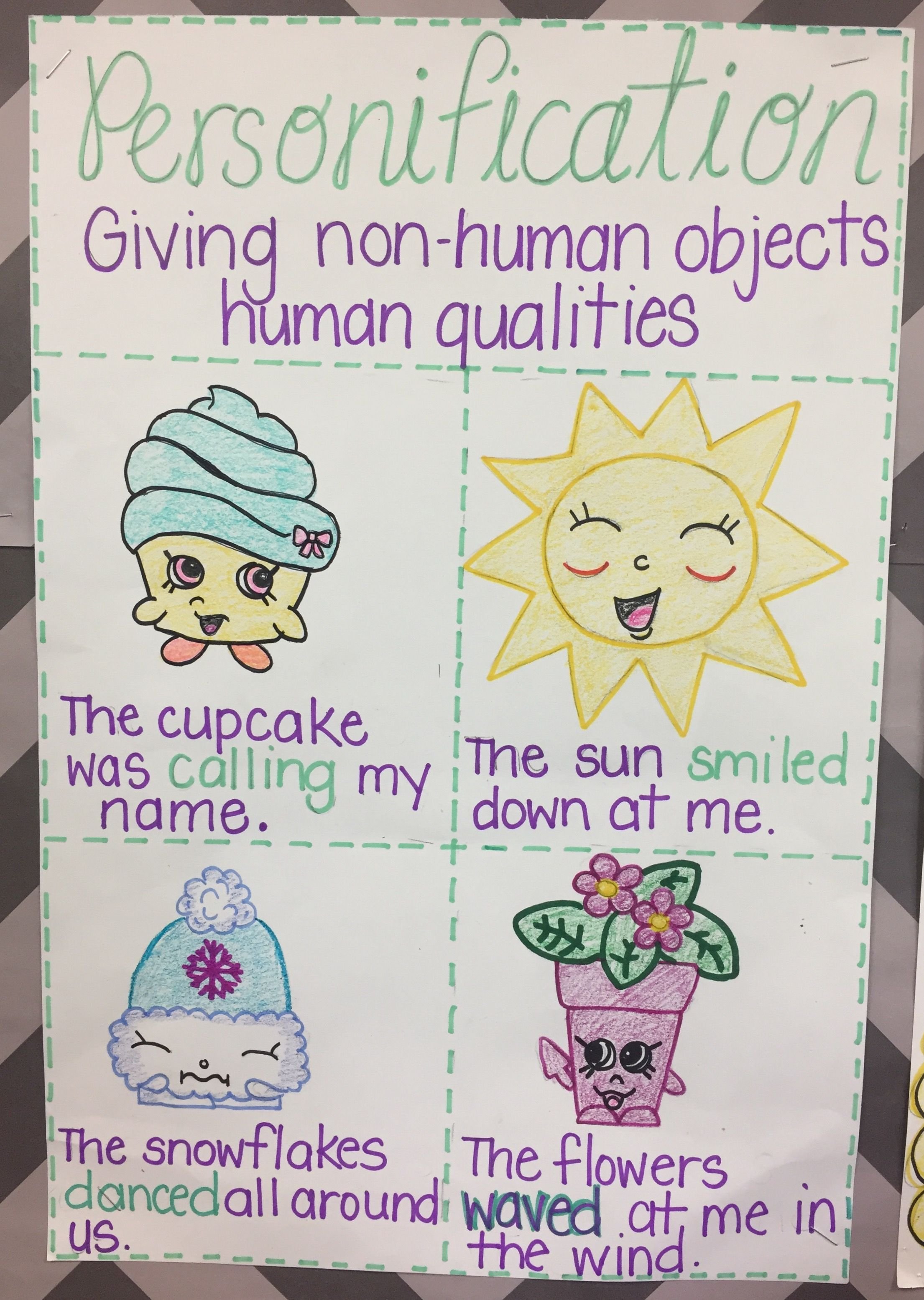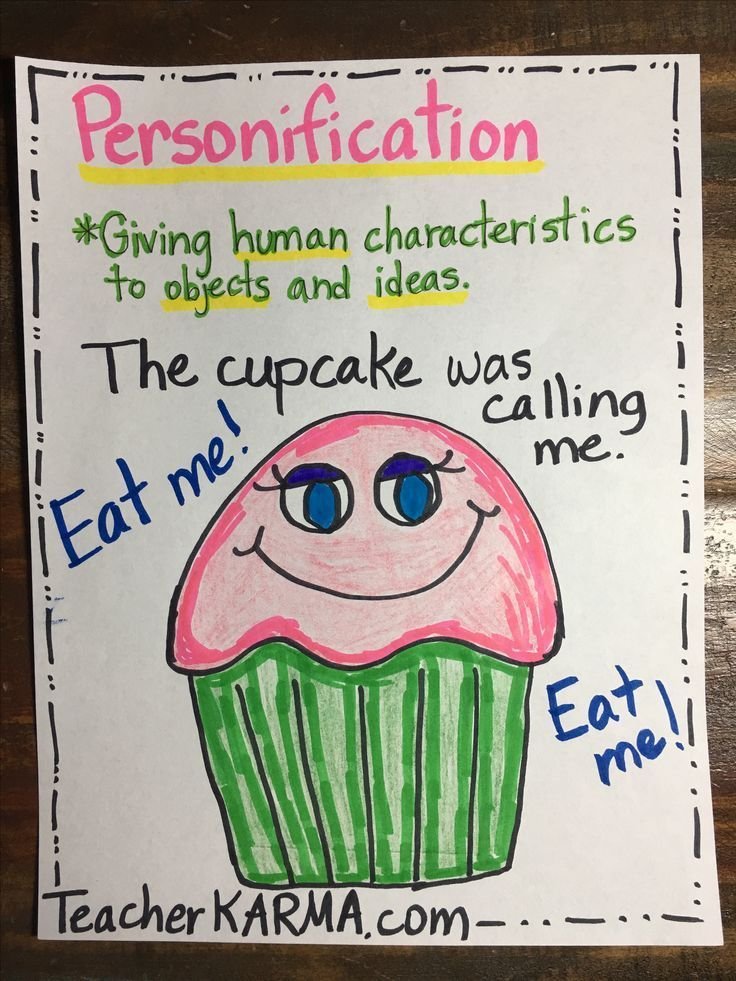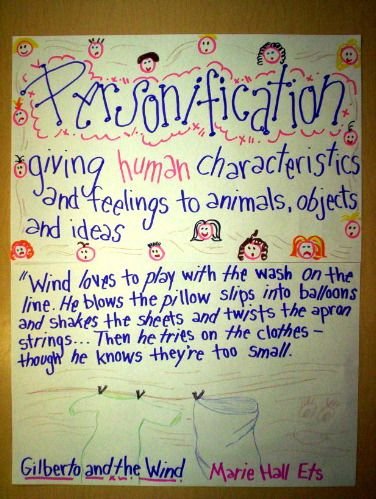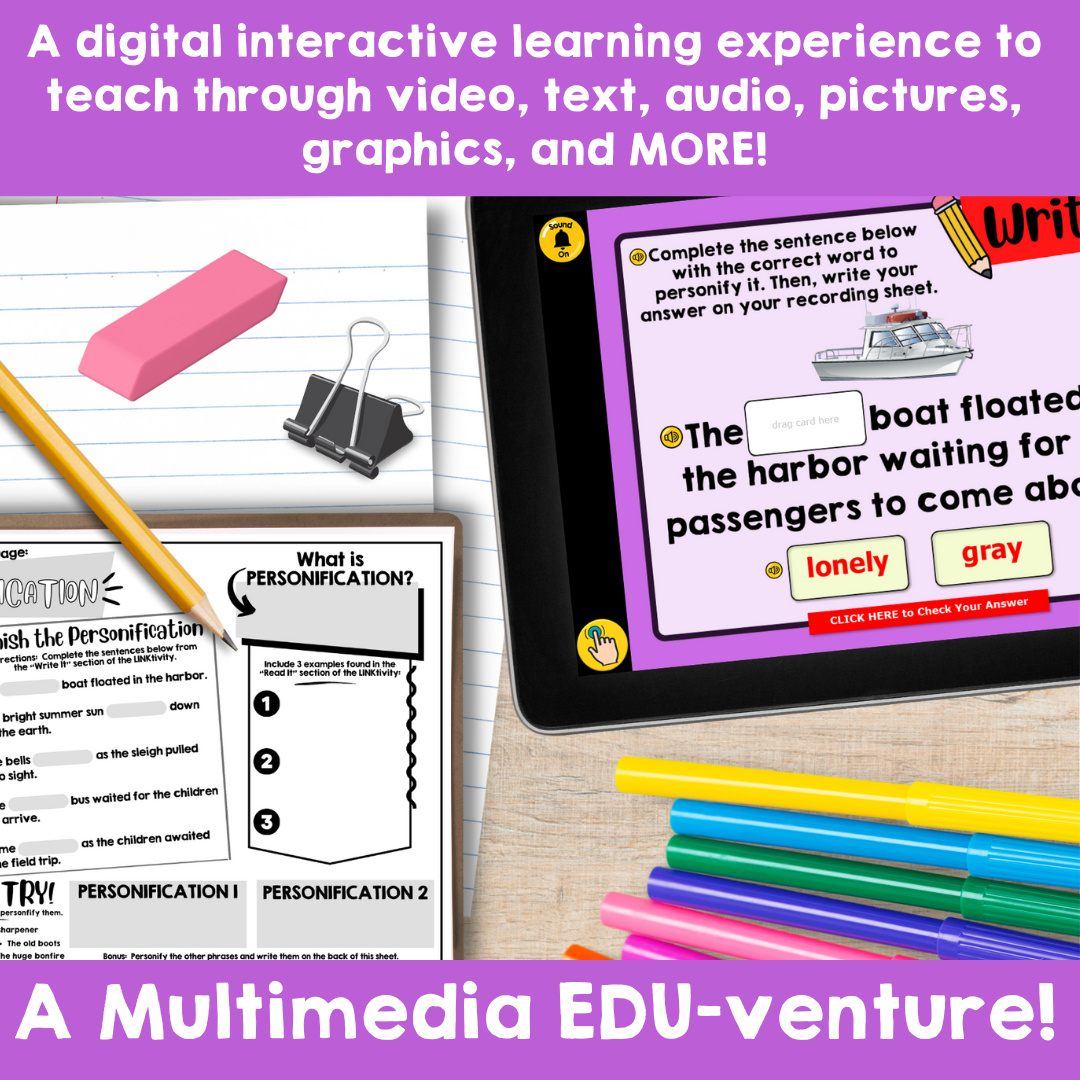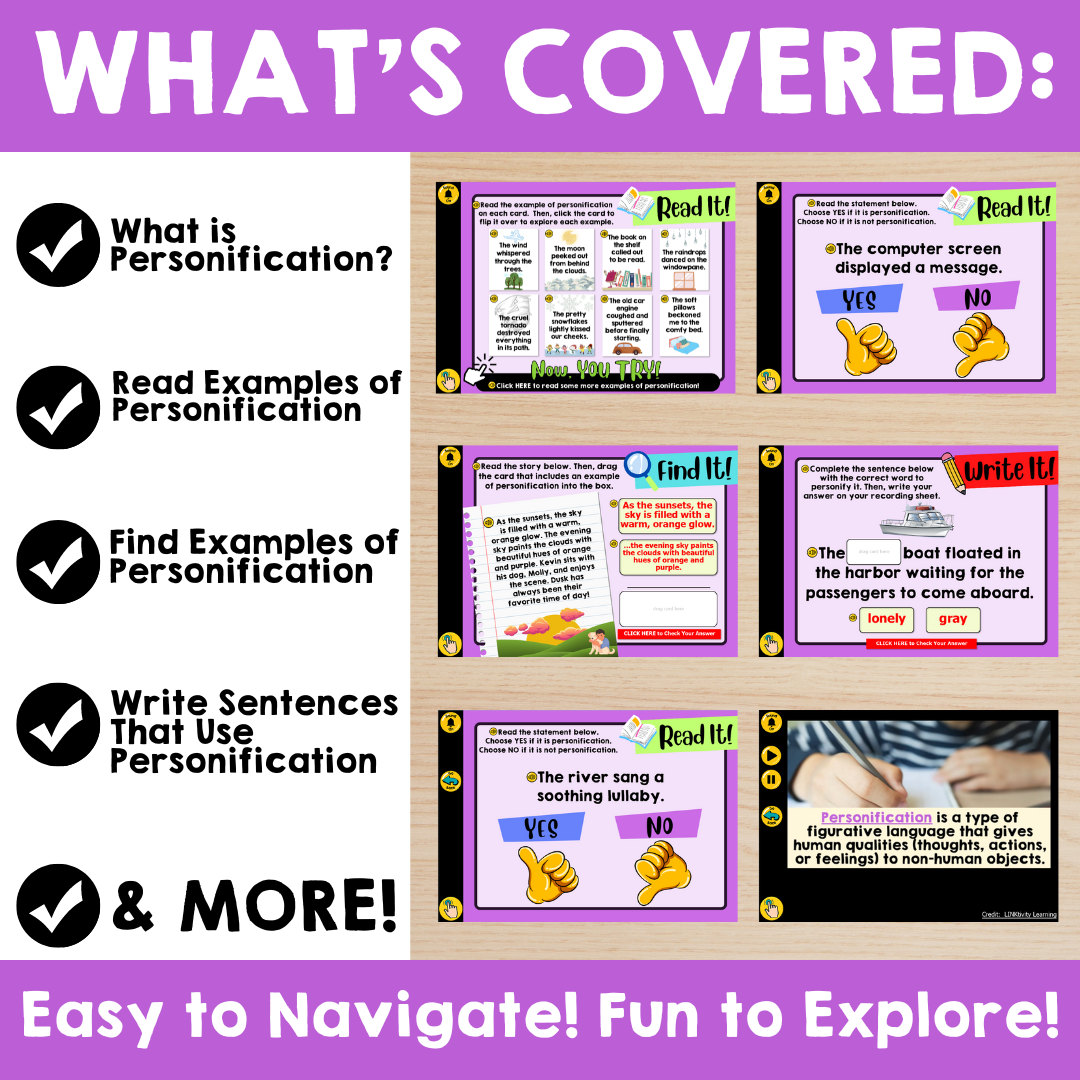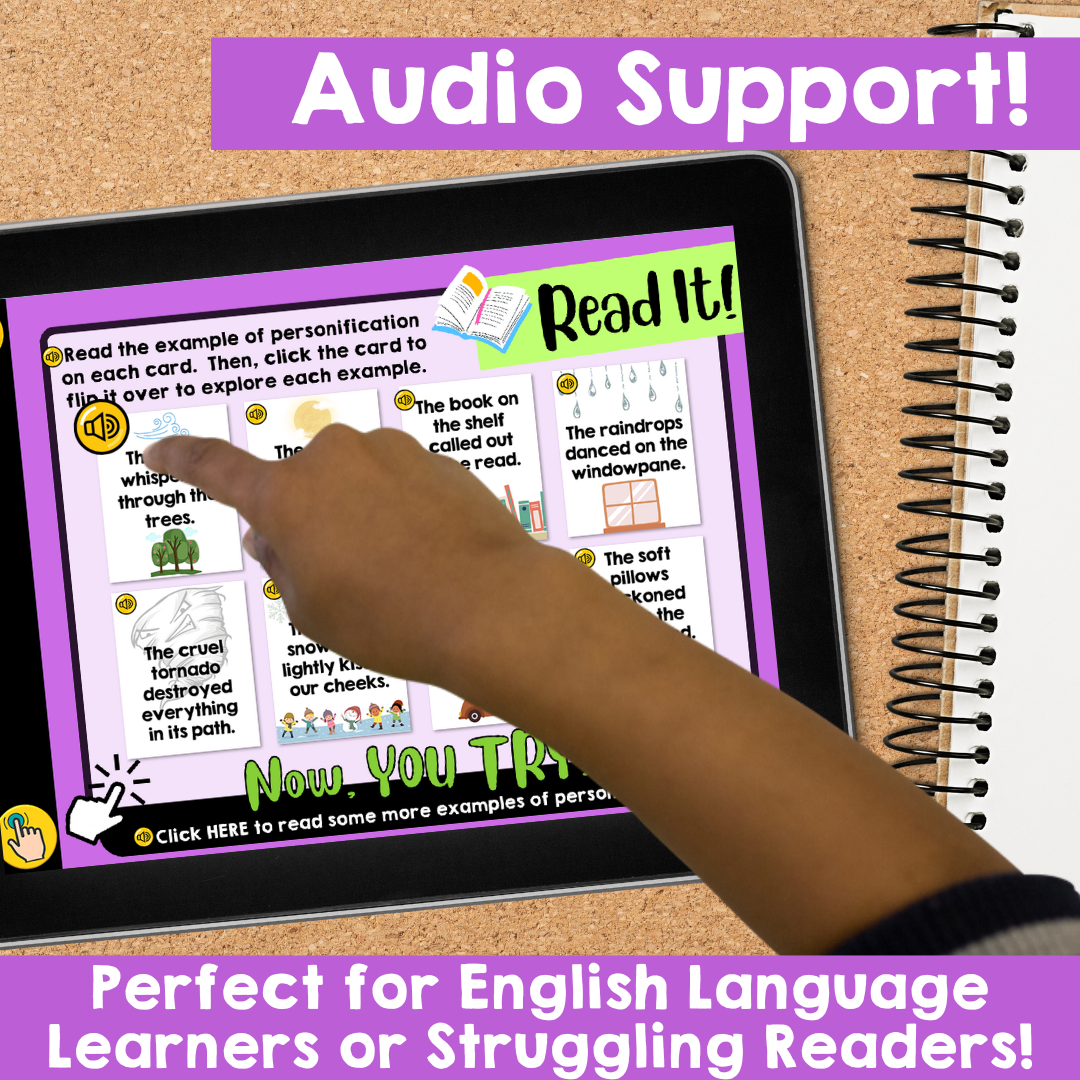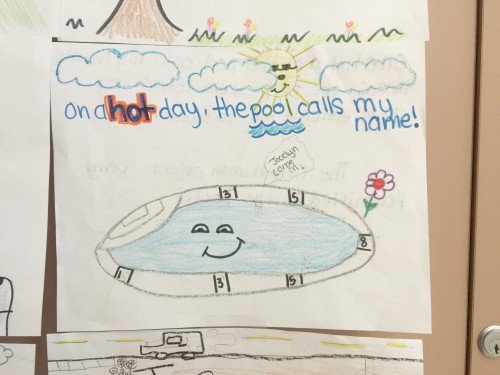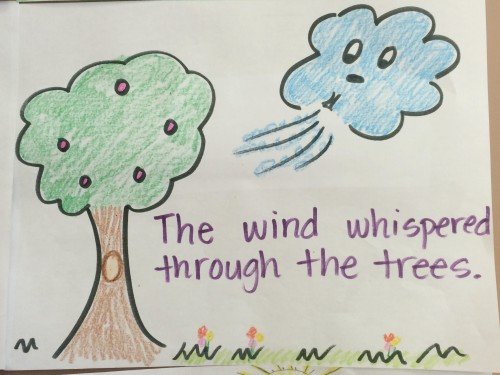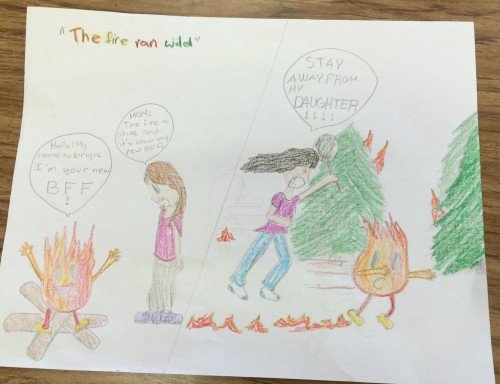Exploring Figurative Language: Fun Strategies to Teach Personification to Elementary Students
Teaching figurative language to elementary students in grades 3, 4, and 5 can be a fun journey into the world of language and imagination.
Specifically, personification, the art of attributing human qualities to nonhuman things or animals, not only enriches students' understanding of literature but also nurtures their creativity and language skills.
As educators, introducing types of figurative language like personification in our classrooms opens doors to a deeper appreciation of language and storytelling, empowering students to express themselves in vivid and engaging ways.
By incorporating interactive and hands-on experiences, we create memorable learning moments that resonate with students. Engaging lessons not only capture their attention but also inspire curiosity and critical thinking, fostering a love for language and literature that lasts a lifetime.
In this post, we'll explore a range of exciting strategies and activities designed to make teaching personification a rewarding and transformative experience for both educators and students alike.
If you’ve been following along, you’ll note that this post is part of a 6-part series all about how to teach figurative language to your students. We’re tackling each figure of speech one by one so that you can walk away with tips and tools for your third, fourth, or fifth graders!
Other Posts in this Series:
From A to Z: Alliteration Made Easy (Step-by-Step Teaching Strategies)
Hyperbole Lessons & Activities That Will Make Your Class Roar with Laughter
Onomatopoeias (Coming Soon!)
Idioms (Coming Soon!)
What is Personification?
Personification is giving life to objects or animals by making them act, feel, or talk like humans. It's a creative way of making our language more colorful and interesting.
For example, when we say "The sun smiled down on us," we're giving the sun a human-like quality of smiling, even though we know the sun can't actually smile. Personification helps us imagine and understand things in a more relatable way.
In everyday language and literature, personification is everywhere. It's in our favorite stories, songs, poems and even in the way we describe nature.
When we say "The wind howled through the trees," or "The flowers danced in the breeze," we're using personification to make the wind and flowers seem alive and expressive. These examples show how personification can make our writing more engaging and imaginative.
Why Teach Personification?
Teaching personification is like unlocking a magical door to language development and creative writing skills. It's not just about learning a new literary device; it's about expanding our ability to express ourselves in unique and captivating ways. By teaching personification to kids, we help students develop a deeper understanding of language nuances and the power of words.
One of the key reasons to teach personification in the elementary classroom is its role in enhancing students' ability to create vivid imagery in their writing. When students use personification, they go beyond describing objects or animals; they bring them to life in the minds of their readers.
This skill not only makes their writing more engaging but also encourages them to think creatively and experiment with different writing styles. Personification opens doors to a world of imagination and expression, making language learning a thrilling adventure for young minds.
Introducing Personification:
To make the concept of personification more tangible and engaging for elementary students, using an anchor chart can be incredibly effective.
For introducing personification, you can create an anchor chart with a simple definition of personification at the center, surrounded by examples and illustrations that showcase how non-human things or animals are given human-like qualities in literature and everyday language. This visual representation helps students grasp the concept and encourages active participation in discussions.
These teacher-created anchor charts can serve as inspiration for creating your own.
After introducing personification, begin with a straightforward whole-group activity.
As a class brainstorm a list of 10 human actions, feelings, and thoughts together. This collaborative effort helps students grasp the essence of personification in a relatable context.
Next, prompt students to observe their surroundings and together, compile a list of 10 objects they can see in their classroom. Encourage them to look beyond the obvious and notice everyday items with potential for personification.
With both lists side by side, encourage students to creatively combine the human qualities with the objects to create humorous or intriguing pairings.
They might invent phrases like "laughing pencil" or "whispering sandwich." These word combinations serve as the building blocks for crafting poetic sentences that bring the objects to life.
For example, you might write, "My worn-out eraser chuckles at my mistakes," or "The dusty bookshelf grumbles about the weight of knowledge it holds." This activity not only reinforces understanding of personification but also sparks imaginative writing and playful language exploration.
FREE POSTERS
Snag this FREE set of 7 posters to display in your classroom as you teach about types of figurative language.
Mentor Texts, Poetry, and Song Lyrics that Use Personification:
Exploring mentor texts, poetry, and song lyrics that use personification provides students with real-life examples of how this literary device is used by writers and artists to create vivid imagery and evoke emotions.
Here are different ways to utilize these texts effectively and gradually release responsibility to your students:
Begin with Read-Alouds and Class Collaboration: Use mentor texts as read-alouds during your reading mini-lessons. Collaborate as a class to identify examples of personification within these texts. Create a class chart to highlight and showcase these examples, reinforcing understanding and engagement.
Transition to Small Group Exploration: Provide small groups with mentor texts, poetry, or song lyrics containing personification examples. Encourage students to go on a hunt within their group to find instances of personification in the given texts. This activity promotes teamwork, critical thinking, and deeper comprehension of the literary device.
Apply Learning with Independent Reading Exploration: Set up a basket of texts containing mentor texts, poetry collections, or song lyrics with personification for students to explore during their independent reading time. Encourage students to keep track of the personification examples they find by using a graphic organizer or maintaining a reading journal. This fosters independent exploration and reinforces the recognition and application of personification in various contexts.
Here are a few text to kickstart your exploration:
Mentor Texts:
My Friend Earth by Patricia MacLachlan
A New Green Day by Antoinette Portis
What Do You Do With a Chance? by Kobi Yamada
The Giving Tree by Shel Silverstein
Outside In by Deborah Underwood
The Night Box by Louise Greig
The Dark by Lemony Snicket
Old Wood Boat by Nikki McClure
Poetry:
Hey Diddle Diddle by Mother Goose
The Adventure of Timothy's Bike by Kelly Roper
The Sky is Low by Emily Dickinson
Trees by Joyce Kilmer
April Rain Song by Langston Hughes
Songs:
🎵How Far I’ll Go (from Moana)
See the line where the sky meets the sea? It calls me. And no one knows, how far it goes
🎵Let It Go (From Frozen)
Snow glows white on the mountain tonight, not a footprint to be seen.
The wind is howling like this swirling storm inside
Let the storm rage on
🎵True Colors (from Trolls)
I see your true colors shining through, I see your true colors
🎵Brave - Sara Bareilles
Nothing’s gonna hurt you the way that words do, And they settle ‘neath your skin. Kept on the inside and no sunlight, sometimes a shadow wins
Say what you wanna say and let the words fall out
Fun Activities to Reinforce Personification Skills
With a little personification practice under their belts, students are ready for some fun! Check out these interactive activities for reinforcing personification skills.
Personification LINKtivity:
Kick off the fun with a Personification LINKtivity®! Teachers have been loving our LINKtivity series all about figurative language. And our LINKtivity on personification has been a big hit!
In our Personification LINKtivity, students are immersed in a dynamic learning experience where they can see, hear, and practice using personification in various contexts.
It all starts by sharing a captivating video that introduces and explores the concept of personification. You can use our personification video to engage students visually and audibly.
After watching the video, guide students to practice reading, identifying, and writing personification examples all within the LINKtivity platform.
This multimedia, interactive approach enhances their understanding and application of personification in a digital learning environment.
Small Group Personification Activity:
Divide students into small groups and provide each group with a non-human object or a picture of a non-human thing such as a shoe, pencil, plant, raindrops, flower, bird, lion, sun, etc.
Encourage students to brainstorm human-like qualities and characteristics for their assigned object. They can either verbally share their personified object with the group or write a descriptive sentence on paper.
This collaborative activity fosters teamwork, creativity, and critical thinking as students bring inanimate objects to life through personification.
VARIATION: Turn This into a Gallery Walk Activity!
Instead of assigning each group a specific object, scatter these objects around the room and place a chart paper next to each one. Invite students to embark on a journey around the room, visiting each object and recording their ideas for human qualities that could be associated with each object.
As students move from object to object, encourage them to think creatively and jot down their observations and ideas on the chart paper. This interactive approach not only promotes critical thinking but also allows students to explore a variety of objects and brainstorm different human-like qualities for each one.
By the end of the Gallery Walk, each chart paper will be filled with a colorful array of human qualities tied to various objects, showcasing the diversity and creativity of students' imaginations. This activity fosters active engagement, collaboration, and a deeper understanding of personification as students connect objects with relatable human characteristics.
Make an Illustration:
Tap into students' artistic talents by having them draw their personified objects. Encourage them to think about how their object would look and behave if it were alive. This visual representation not only reinforces their understanding of personification but also provides a creative outlet for self-expression and imagination. Check out these illustrations from Mrs. Leonardo’s class:
Once complete, these illustrations would make a great classroom bulletin board display or even a class book.
Writing with Personification (Simple Writing Prompts for an Easy Literacy Center):
Set up a simple literacy center that engages students in a writing activity using personification cards. These cards are categorized into Thing, Action, and Location.
In each group, students spread out cards from each category while keeping similar categories together. They then create personification sentences by selecting one card from each category, ensuring that the sentence makes sense and is grammatically correct.
For example, they might create sentences like:
"The raindrops (object) tap-danced (action) outside the window. (location)"
"The book (object) invited me on an adventure (action) to faraway places. (location)"
This exercise encourages students to think critically about word choice and enhances their ability to craft meaningful and imaginative sentences using personification.
Personification Walk:
Often, personification is used to give nature human-like qualities. So - take learning outdoors with a Personification Walk!
Grab paper, a clipboard, and a pencil, and outline an outdoor activity where students observe nature and personify objects they encounter.
Emphasize the connection between observation skills and creative writing as students bring elements of nature to life through personification. While walking around your school, students take note of the trees, the wind, flowers, etc.., and begin to jot down objects of nature along with human-like qualities associated with them.
Sentences like: “The wind whispered through the trees.” or “The leaves waved in the breeze.” both showcase nature being personified.
This hands-on experience not only enhances their descriptive writing skills but also deepens their appreciation for the beauty and wonder of the world around them.
Embracing personification in the classroom offers a plethora of benefits that go beyond just understanding a literary device. Here are some key ways in which teaching personification can positively impact your students:
Boosts Creativity: By encouraging students to attribute human qualities to non-human objects, personification sparks their imagination and creativity. It prompts them to think outside the box and find unique ways to describe the world around them.
Fosters Language Development: Personification enriches students' language skills by introducing them to figurative language in a meaningful context. It helps them explore new vocabulary and understand the power of words in creating vivid imagery.
Enhances Critical Thinking: Engaging with personification requires students to analyze and interpret texts in a deeper manner. They learn to identify figurative language techniques, decipher their meanings, and evaluate how they contribute to the overall message of a piece of writing.
Improves Writing Skills: Incorporating personification into writing activities encourages students to write descriptively and creatively. It teaches them to use literary devices effectively to evoke emotions and engage readers, leading to more compelling and expressive writing.
By integrating engaging lessons and activities focused on personification into your curriculum, you create an environment where students can thrive academically, creatively, and emotionally. Embrace the magic of personification to unlock your students' potential and make learning a truly transformative experience.



